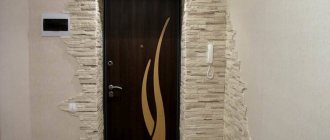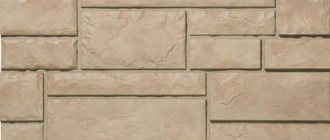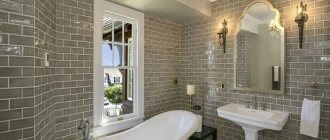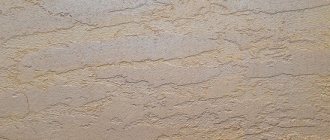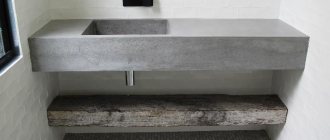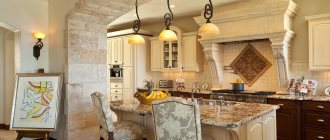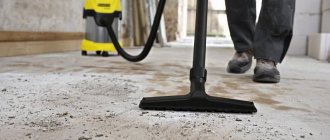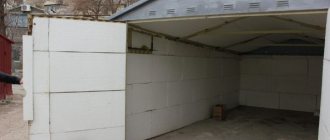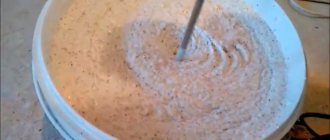Decoration options
Gypsum stone provides ample opportunities for decoration. By painting with this material, it is easy to imitate white or red brickwork and any types of natural stone, from the simplest to the more expensive and luxurious, such as marble. With the help of small tricks and tricks you can even create the effect of antiquity, and no one will say that this finish is only a matter of days or months old.
Imitation of red brick from gypsum decorative stone Source sense-life.com
Artificial gypsum stone in the interior of a bathroom Source rehouz.info
When choosing how to paint a decorative gypsum stone, remember that color affects visual perception. Light shades and small patterns will visually make the room larger and more spacious. Dark colors, on the contrary, seem to compress the space. Therefore, in small rooms, especially if there is little natural light and dim artificial lighting, dark coloring of gypsum stone should only be used spot-on.
What types of paint are suitable for brick and how to choose them
All commercially available painting materials are divided into two large groups - façade and for interior use. The first category is characterized by greater resistance to moisture and temperature changes: facade paint can be used both outdoors and indoors.
Requirements for brick paint:
- Moisture resistance. This especially applies to situations where painting street brick walls is necessary. This will not be superfluous in cases where the interior in the kitchen, bath or hallway needs updating.
- Ability to pass steam. Most types of brick are vapor permeable, and if you create a “blind” layer on top of such a material, this will provoke the accumulation of condensation under the paint layer. As a result, the paint begins to peel off rapidly.
- Good hiding power. Elastic paints are best suited for decorating rough brick surfaces. Due to some plasticity, such a finish will not crack during seasonal or shrinkage deformations of the brick wall.
- Resistance to temperature fluctuations. This is especially true for the outer surfaces of a brick wall, which experience all the charm of climatic influences. Good heat resistance of brick paint will also be needed in cases where additional finishing of brick stoves and fireplaces is carried out.
In general, all paints used for painting brick can be water-based or organic.
Each of the compositions of this type has its own specific application:
- Nitroenamels, oil dyes. They are well absorbed into bricks and withstand sunlight and mechanical stress. However, after their application, a strong hydrophobic film is created on the surface of the material, completely clogging the structure. As a result, condensation begins to appear on the brick wall.
Nitroenamel is not the best choice for painting brick
Organic paints are not recommended for use in residential interiors , as this will provoke dampness of the walls and disruption of the internal microclimate. They are more suitable for decorating brick facades, fences and balconies.
- INsingle-dispersion. An excellent option for painting brick is water-based façade paints. They are presented in several varieties, each of which has specific characteristics. Liquid glass acts as a binder for silicate materials. The degree of their resistance to atmospheric influences is quite insignificant, which is reflected in a rather short service life - up to 3 years.
Water-dispersion paint is a good option for painting brick, but its service life is only 3 years
Acrylic facade compositions are much stronger and more reliable: after hardening, they can be dry cleaned. They also increase the ability of brickwork to withstand moisture.
However, the most suitable water-based brick paint option is acrylic-silicone solution , which can last up to 10-12 years. After drying, the material forms a vapor-permeable layer with good hydrophobic and vandal-proof characteristics. The cost of this paint is quite high, but the result obtained completely compensates for all costs.
Acrylic-silicone paint is one of the best options for painting brick
- Epoxy. The composition of this material may differ slightly: in some cases it contains toxic components, which should be checked with the seller. In general, all epoxy paints are characterized by good adhesion to brick and strength. To increase resistance to climatic influences, after the paint has hardened, it can be hidden with a layer of varnish.
Epoxy paint is durable and adheres well to brick
- Mineral . The basis of mineral paints is cement. They can be used to decorate brick facades, fences and balconies. After hardening, the coating resists moisture, temperature fluctuations and mechanical stress well. Typically, mineral dyes are used for exterior work.
Mineral paint is good for brick
- Silicone. An excellent option for very smooth brick walls with low adhesion. Basically, sand-lime brick has these characteristics. There is a line of heat-resistant silicone paints specifically for finishing stoves and fireplaces.
Silicone paint is perfect for sand-lime brick
How to paint gypsum decorative stone
There are several options for painting gypsum stone, and each will allow you to achieve different effects.
Applying paint to artificial gypsum stone Source roomester.ru
Varnish
Semi-matte varnish for coating decorative gypsum stone Source cs.petrovich.ru
To emphasize the natural color and texture of the material, use a simple transparent varnish.
- Semi-matte or matte varnishes will set off the color of gypsum tiles and restore its richness.
- If you use a glossy varnish, you get the effect of a wet stone. It looks interesting, but less natural.
Dye
To achieve a more even and smooth surface and/or to change its tone more radically, you will need paint. You can get absolutely any color. There is a wide range of ready-made paints in different tones on sale. But if there is no suitable shade, you can make it yourself by mixing two or more colors, or adding a suitable dye.
White paint for decorative gypsum stone Source altusa.ru
Color schemes for later color painting of gypsum decorative stone Source gidpokraske.ru
The latter are produced in the form of dry powder or liquid. Dry formulations must first be diluted (usually with water), but liquid ones are ready for use; just shake or stir them.
Different types of paints are suitable for painting decorative stone, but acrylic paints on water are best. It easily adheres to the plaster texture, provides a rich color and dries quickly enough. A separate plus is that there will be no specific smell inside the room.
Silicone-based paint for decorative gypsum stone Source 2proraba.com
If the gypsum stone will be used in conditions of relatively high humidity, for example, in the kitchen, on the veranda or on an unglazed balcony, it is recommended to use silicate and silicone-based paints. They will significantly reduce the water permeability of this finishing material.
Paint for decorative gypsum stone laid on the street Source kapitel38.ru
We remind you that it is precisely because of this high water permeability, that is, the ability to absorb moisture and be saturated with it, that artificial gypsum stone is not used for outdoor decoration. To do this, decorative bricks with the desired finish and a hydrophobic layer are used.
If desired, the two painting options can be combined: first apply the required number of layers of suitable paint, and then fix it and emphasize the brightness of the tone with matte or glossy varnish.
How to make plaster stronger - the secrets of reliable modeling!
Gypsum itself is a fairly strong material, but it wouldn’t hurt to make it even stronger, maybe 10 times stronger! This can be done both at the stage of mixing the solution, and after the product is ready. In the first case, for all the manipulations you will only need knowledge and a little lime and PVA construction glue, but in the second case you will have to go to the hardware store for iron sulfate or zinc sulfate. The easiest way to increase strength is to reduce the proportion of water in the solution.
If an ordinary solution is mixed at the rate of seven parts of water to ten gypsum, then a stronger one is made from six portions of water for the same ten gypsum.
If you overdo it with reducing the amount of liquid, you risk getting plaster crumbs. Varnish natural stone outdoors? The risk can be reduced by adding PVA glue to the solution.
You only need a couple of tablespoons per average batch for the finished structure to gain greater strength - the glue binds individual particles of gypsum. A mixture of gypsum and slaked lime demonstrates an amazing effect, but all that is needed is to add one part of calcium hydroxide to the standard ratio. Of course, the product or surface will not become invulnerable, but it can survive a fall to the floor from a table or a blow from a blunt object. If you have a finished product on your hands, you can soak it in a concentrated solution of zinc sulfate or iron sulfate.
Zinc salt will not change the color of the product, but vitriol will turn it yellow-brown.
Unusual dyeing products
Drying oil for impregnation of gypsum coating Source kraski-net.ru
Coloring gypsum stone with rosin Source ozone.ru
Colored stain for decorating artificial gypsum stone Source insales.ru
- Drying oil. The main areas of its use are the base for paints and wood impregnation. When applied to a plaster coating, it creates an unusual effect of aged stone in warm beige-brown tones.
- Rosin and varnish. These two substances, when mixed with technical alcohol, can color light plaster into a brownish-red color, reminiscent of old ceramics.
- Stain. This compound is also commonly used on wood, but can be used just as well on plaster. The stain is available in various shades of red-brown colors.
Painting stages
Painting artificial stone is not difficult: you can do without special tools and technologies. The gypsum texture masks minor defects in the material. The main thing is to properly dilute the composition.
Pay attention to: Painting a brick wall: choice of paint and surface preparation, painting technology
Preparing the stone
Careful preparation of the material is required before painting. Before painting, the part is inspected to ensure there are no defects. New stone is easier to process than old stone. Only wash, soak twice, dry, and apply dye. From old tiles:
- clean off the cracked layer of pigment;
- carefully polish the surface;
- remove remaining dust with a stream of air or a rag;
- impregnate with primer 2-3 times;
- dry thoroughly.
Typically, impregnation is chosen with antiseptic or water-repellent properties.
Coating
Decorative stone is painted in different ways - before and after facing. It depends on the experience of the performer and the amount of work. Painting the finished wall covering will immediately show the result. It is important to accurately calculate the ratio of light and shadow. You should not use more than two shades. Plaster often absorbs pigment differently and produces different tones in different areas. The most common processing method is adding dye to the gypsum mass. The stone turns out to be colored from the inside. The pigment on the wall stays stronger if the stone is impregnated with a primer before coating. After the background coating, darker shades are applied to individual areas to give an aging effect. After drying, the work is completed by applying a layer of varnish to the stone.
The result of coloring artificial stone
Technology of applying paint to gypsum stone, preparing the stone for painting
Tinting gypsum stone before installation Source ytimg.com
Painting gypsum stone after its installation Source ogorodsadovod.com
Painting of decorative gypsum stone can be carried out both before and after its installation on the walls. There will be no significant differences in the technology of work; it is a matter of convenience in each specific situation.
Removing dust with a brush from plaster finish before painting Source laminatepol.ru
In order for the paint to adhere as desired, the decorative stone must be clean. Wipe it clean and remove any other unwanted dirt, including any glue residue. If there are chips or scratches that you want to get rid of, this should also be done before painting.
Dilute the gypsum mixture according to the instructions on the package and cover the problem areas with a spatula, finger or other tool convenient in this situation. Be sure to let these patches dry thoroughly before painting.
Primer for gypsum coating for pre-treatment before painting Source formako.ru
An optional, but desirable step is applying a primer. It will provide stronger, more reliable and durable adhesion of the dye and the surface of the stone. Two important points: the primer must be compatible with the paint, and it must be allowed to dry before painting.
How to paint brickwork: 9 important points
Fireplace portals, kitchen aprons, fragments of old walls and new decorative masonry - brick is constantly found in the interior, it is not going out of fashion and is increasingly becoming an object for design experiments. The easiest way to update a brick wall yourself is with paint - however, when painting you need to take into account several important details.
There is no way back
If you are determined to repaint a brick wall, you should know that it is almost impossible to remove paint from it. The original terracotta cannot be returned; the color can only be changed by repainting. And repainting will definitely be required: in five years the paint will most likely fade and even crumble.
Natural means capricious
Brick is a porous, breathable material. Building codes and regulations require long periods of weathering and drying. If you decide to paint a new wall that has stood in its original form for less than a year, be prepared for surprises: efflorescence and moisture stains can ruin the texture of the painted wall.
Thorough preparation is the key to success
The surface must be clean before painting. All salt stains must be removed with a wire brush (never use acid!). Wash the wall with soapy water and leave to dry: the brickwork needs about a week for all the excess moisture to come out of the pores.
Focus on results
The whole personality of a brick is in its rough texture, this is true, but large flaws are still better to be plastered or puttied. The romantic charm of antiquity will not go away, but painting over masonry without chips and cracks is much more convenient. And the finished surface looks neater.
Choosing paint - safety and visual effect
The main thing is not to choose façade paint by mistake. Of course, such materials are better suited for painting porous surfaces, but they contain many volatile substances that are hazardous to health. You will need interior paints - you can choose acrylic or alkyd for a matte or semi-gloss effect. Or use oil paint - it will give the brickwork a soft shine.
Primer - the main thing behind the scenes
The primer should be selected taking into account the choice of paint, but in any case it should penetrate deeply into the base and create a durable water-repellent film. Apply a thick layer of primer - and be sure to let it dry completely.
Smooth color or special effects
It is better to paint a brick wall with a brush - it is easier to feel contact with the surface and apply even strokes. The direction of painting is horizontal, according to the masonry pattern. For acrylic paint, brushes made of polyester fiber are recommended (but high quality!), alkyd and oil paints require brushes made of natural hair. The universal size and shape of a tool for painting walls is a flat brush with a width of 75 to 100 millimeters. To work out the corners, brushes that are twice as narrow, with an obliquely cut edge, will be useful.
It is better to use a roller if you want to achieve the effect of a primer layer: brick absorbs a lot of paint at once, so it will take a long time to work with a roller on a smooth coating. But a carelessly rolled layer will turn out quickly and easily!
If you apply paint with a sponge, you will get the effect of old faded masonry. In this way, you can whiten the wall and make the paint layer translucent (as in the case of working with a roller). You can use a sponge to apply bronze or silver highlights, add spots of contrasting color to the wall, or paint over images using stencils.
Another common (but more labor-intensive) painting method is to paint each brick with a paint of the same tone using a brush and use a contrasting color compound for the joints.
How to prepare paint
After standing on a shelf for a long time, any paint begins to flake a little - it becomes thinner at the top and thicker at the bottom. If you apply it in this form, the color will turn out uneven. Therefore, the paint must be mixed before use.
Mixer attachment for convenient dilution of building mixtures Source saratov24.tv
It is best to do this using a special attachment on a drill or hammer drill, especially when it comes to large volumes. In principle, paint in a small jar of a couple of liters can be mixed manually with a brush or wooden stick.
You should act in the same way when combining several colors of paint or adding a colored pigment. It’s not enough to just pour them into one container, you need to mix them well.
Improving the performance of gypsum finishes
Manufacturers of alabaster cladding most often offer consumers products that have already undergone a process of improving characteristics and are varnished. The price of such material is higher due to the cost of additional processing. Knowing the optimization technology, you can purchase gypsum cladding without protective treatment, for example, the popular hand-made Monte Alba decorative tiles, and independently improve the properties of the material, and then varnish it. Let's consider what the pre-treatment of gypsum products is before applying varnish, types of varnish compositions and methods of their use.
Impregnation of gypsum tiles with hydrophobic agents
To neutralize the hygroscopicity of gypsum products, they are hydrophobized, which consists of impregnation with water-repellent compounds (hydrophobizers) based on organosilicon polymers. Due to the deep (up to 20 mm) penetration of water repellents into gypsum without the formation of a film, porosity is reduced, but the vapor permeability of the products is maintained, the degree of hygroscopicity and the susceptibility of tiles to mold are reduced.
Impregnation allows you to preserve the attractive appearance of stone and decorative stone tiles for a long time
Water repellents are offered by manufacturers in the form of ready-to-use solutions, as well as concentrated formulations that require dilution. The method of use is indicated on the packaging of the mixture.
The general requirement for the use of hydrophobic compounds is that they be applied to completely dry gypsum tiles that are free of dust. Gypsum products are processed on all sides in two layers until saturated, without waiting for drying. This processing method reliably isolates the cladding not only from the humidity of the outside air, but also from the moisture of the base material. For application, depending on the area of the surface to be treated, a brush or roller is used.
Water repellent Tiprom
The treatment should be carried out wearing protective glasses and gloves, avoiding contact of the composition with exposed skin. Contamination of adjacent glass and metal parts with a water-repellent agent must be promptly eliminated, as the composition hardens quickly.
Examples of well-proven hydrophobic compounds include:
- water-repellent silicone composition White Hill;
- silicone impregnation “Optimist C405 – Natural stone”;
- a range of Tiprom water repellents.
Silicone waterproofing impregnation – Natural Stone
Varnishing the plaster finish
After hydrophobization of the alabaster tiles, the base is faced by laying gypsum products on an adhesive mixture selected in accordance with the type of wall surface. A day after installation is completed, they begin to decorate the finish with paints.
To protect the artistic layer of the cladding, it is necessary to cover the tiles with a protective varnish layer. This operation begins after finishing the decoration, but not earlier than 5-10 days after finishing laying the tiles, so that the tile adhesive under the finishing not only hardens, but also dries.
To apply a protective coating to gypsum tiles, acrylic or oil varnish is used. These materials differ in properties, so we will consider each separately.
Protecting alabaster tiles with acrylic varnish
Acrylic varnish is a ready-to-use aqueous dispersion of resins, a milky liquid, the application of which to interior and exterior decoration is used for protective and decorative purposes. This solution is resistant to cracking and forms a durable, transparent film on the surface, which after drying can be removed using a special solvent.
The acrylic-based coating is resistant to detergents, moisture and ultraviolet radiation, and temperature fluctuations. The composition is odorless, harmless to humans and the environment, dries quickly and becomes transparent. Acrylic varnish is diluted with water to the desired consistency and applied to the surface with a brush, roller or spray.
Varnish for natural and piece mineral surfaces
Acrylic varnish is available in three types: glossy, matte or semi-matte.
When applying a glossy solution to gypsum tiles, it should be taken into account that the cladding will receive shine and glare from the lighting, which will distort the colors of the tile decoration.
Matte acrylic varnish will preserve the velvet surface of the tile, imitating rough-cut natural stone, without changes. This composition is an ideal protective coating for Monte Alba tiles.
The semi-matte type of varnish occupies an intermediate position between the two described types in terms of its effect on the cladding.
When dry, a thin film is formed that prevents moisture from being absorbed into the plaster.
When decorating gypsum cladding, which was painted with water-based paints, 10% acrylic varnish can be added to the emulsion to enhance adhesion to the gypsum. After covering with two layers of such paint, only one layer of varnish can be applied to the alabaster tile.
Important! If you do the opposite, add paint to the acrylic solution, the coating will end up with paint-colored stripes, which is not always desirable.
An example of a successful choice of protective and decorative coating for gypsum finishing is Finnish paint and varnish products.
Coating gypsum tiles with oil varnish
Oil varnish is a solution of natural or artificial resins in oils of plant origin. After application to the base, such varnish first forms a film on the surface of the layer, and then dries throughout its entire thickness and serves as a strong protection for the surface from mechanical and physical damage.
Oil varnishes, like acrylic varnishes, are available in glossy and matte finishes. To bring the solution to the desired consistency, special thinners are used that do not change the characteristics of the varnish. Oil-based varnishes are available colorless or transparent, but have some tint, so when choosing a material for coating gypsum tiles, you need to take into account the compatibility of the varnish shade with the color of the alabaster finish. All oil solutions, including colorless ones, darken a little after drying, which also needs to be taken into account when decorating gypsum tiles.
Using yacht varnish
The most durable coating is provided by yacht oil varnish, so its use to protect plaster cladding is most advisable. After thoroughly mixing with the thinner, the varnish is applied to the finish in a thin layer with a brush or roller. The solution should be well distributed over the surface, avoiding the formation of drips. Yacht varnish dries, depending on the room temperature, in about a day.
Varnish for gypsum tiles is an indispensable thing for giving the surface the desired shade or glossy shine.
After the first layer has dried, the cladding is inspected for the presence of drips, which must be carefully sanded with fine sandpaper before applying the second layer. The second layer of varnish also dries for about a day, after which the varnished finish is wiped with a clean, damp, soft rag to eliminate any residual adhesion.
Decorative tiles "Monte Alba", covered with a protective layer of yacht varnish, despite the corrugated surface, are easier to keep clean and last longer.
Dyeing process
A set of brushes of different sizes for painting gypsum stone Source zubr-vrn.ru
Spray gun for painting gypsum decorative stone Source gidpokraske.ru
To apply paint, you can use brushes or a spray gun or an airbrush. A roller is not suitable for such surfaces, especially if the stone is already painted on the walls. This tool will not be able to achieve a smooth and uniform coating, and unsightly streaks will form in the spaces between the tiles.
Applying paint to gypsum decorative stone using an airbrush Source gidpokraske.ru
The dyeing technology itself does not differ significantly from that for other types of finishing materials:
- The paint is applied gradually, from bottom to top, with a convenient brush of suitable width. It is important to add neither too much nor too little mixture so that you get an even layer of color without drips.
- Using a spray gun, paint is also applied from bottom to top, from a distance of 30-50 cm from the wall. Remember that the closer you hold the device, and the longer you hold it in one place, the thicker and brighter the color the paint layer will be.
- The varnish can be purchased already in a spray can or also poured into a spray gun. Or you can use a brush, preferably a fairly wide one.
- Stain, drying oil and rosin are more convenient and easier to apply with a brush.
Painting plaster – what colors does plaster like?
Gypsum is present both in plaster mixtures and as an independent material for the same modeling that we use to decorate our homes. And not always its natural whiteness may suit you in terms of combination with other interior elements or simply not suit you - it’s too easy to stain such parts during cleaning. It’s much easier and more interesting to paint plaster surfaces or elements! Of course, you won’t be able to take watercolor paints and give the desired color to plaster products; this process has its own secrets.
It's time to lift the veil of mystery!
In principle, plaster, like almost any natural material, can easily be applied to all kinds of paints and varnishes, gilding and other simulators of silver, bronze, and even ivory! Acrylic paints adhere well to a plaster surface, however, adhesion to this material is high for almost all compositions. For better preservation of the paint layer, it does not hurt to apply an additional layer of colorless varnish; by this time the paint should be completely dry.
What glue is used when working with gypsum-based decorative stone?
Glue for installing decorative gypsum stone on walls Source stroy-podskazka.ru
Gypsum stone for decorative wall decoration is a very light material. It is installed using the following compounds:
- Putty with an admixture of gypsum.
- Tile adhesive with a mixture of gypsum.
- Acrylic putty.
- Special PVA.
- Gypsum mastic.
- Sealants for installation.
- Glue of the “Liquid Nails” or “Velcro” type.
You should choose a suitable glue based on its ease of use, availability in suitable packaging and your own financial capabilities.
Tools needed
The choice of tool depends on the type of tile. To paint finished purchased parts you need a minimum of equipment. To process stones with old coating, the list of equipment is expanding. For successful work, prepare in advance:
- paint sprayer or airbrush;
- set of brushes;
- gloves;
- rubberized sponge for correcting and smoothing out imperfections;
- grinding tools;
- impregnation;
- degreasing composition;
- a vacuum cleaner to immediately remove dust and waste;
- a piece of fabric to correct imperfections.
Pay attention to: How to paint slopes?
Before painting, the decorative stone is prepared (the old layer is cleaned and treated with impregnation).
Sander
Airbrush
Tips for painting decorative gypsum stone
- If you made the gypsum tiles yourself, let them not only harden, but also dry completely. This will provide it and the color coating with strength and durability.
- If the decorative stone was purchased ready-made, leave it indoors for 2-3 days so that it adapts to the existing temperature and humidity conditions. This measure will protect the material and its coating from shrinkage or, conversely, expansion after installation.
- If you are not sure that the chosen paint will apply as it should, test it somewhere in an inconspicuous place in the masonry or on a spare element of the stone.
- Remember that in liquid form the paint looks much darker than it will after application and drying. The actual color (or colors depending on the proportions when mixing when talking about color) is usually printed on the label.
- Gypsum stone can be repainted several times. But to ensure that the new paint applies evenly, it is better to sand the surface with sandpaper or something similar.
Be sure to carefully read the instructions for all paints, tints, glue, primer and other products used. There may be features and nuances in their use that are important to observe in order to obtain the desired result.
Caring for painted brick surfaces
Caring for a painted brick wall is very simple: it must be periodically wiped with a soapy solution using a sponge. If local damage or paint peeling is detected, simple restoration measures are carried out. To do this, you need to carefully clean off the exfoliated fragments using a scraper, then prime and carefully putty the resulting depression. After drying, the sealed area is lightly sanded and painted. To achieve complete invisibility of the repaired area, it is advisable to use paint from the same series as for the initial decoration.
In terms of labor costs, painting brickwork is much more profitable and easier than plastering or cladding. If everything is done correctly, a painted brick facade will perfectly retain its decorative qualities for at least 5 years (interior decoration usually lasts much longer).
How and how to paint a brick (brick wall)
Brick Paint Spray gun Painting repair DIY walls
Applying a layer of rotbands
To test the entire color selection technology, it is better to first do all the work on a small sample made of fiberboard or plasterboard. Thus, it is better to choose the required color for the brick and test the work with the rotband. When simulating brickwork from rotband, it is necessary to take into account that the rotband mixture hardens in 25 minutes and it is necessary to knead such an amount to work it out during this time - approximately 1-2 square meters. meters. Rotband gypsum mortar is mixed in a small bucket and applied with a spatula to the prepared wall surface in a layer of 3-5 mm.
It is better to start from the upper left corner and plaster a certain grip in the form of a rectangle. In this case, whether the surface is smooth or not does not matter much.
Carefully remove the tape from the wall
After the solution has been worked out, but no later than 20 minutes of plastering with rotband, it is necessary to remove the tape until it has completely hardened. After two or three batches it will be much easier to do. Until the plaster has completely hardened, various irregularities, cracks, and pits can be applied to its surface using a spatula, which will create an imitation of brickwork in the apartment. After plastering the entire surface of the wall and removing the tape, you need to let the plaster dry for about a day.
After this you can start painting.
General information
Application of gypsum
Gypsum stone has a beautiful shape, and it also closely resembles brick or faux tiles, and also looks great when facing doorways and walls. Moreover, it can be used in combination with tiles, plaster, wood, photo wallpaper, as well as simple wallpaper. Gypsum stones are used either as fragmentary or complete finishing of premises. The stone is used for cladding fireplaces and emphasizing the base of columns. Gypsum stucco molding is sold in hardware stores, and they also sell moldings made from this material, used to decorate walls and ceilings. From gypsum powder you can make beautiful figurines for the garden, figurines, and various sculptures.
Advantages
Various building mixtures are made on the basis of gypsum, both for internal and external types of work. Dry gypsum is added to many putties, adhesives and plasters as an excellent binding component. This material is added to the majority of many construction and finishing materials, because it will have the following advantages:
External beauty.- A small mass that will be combined with a high degree of strength.
- Creates excellent noise and heat insulation.
- They can be used to make beautiful, unique products for decorating the exterior and interior.
- Environmentally friendly and safe material for human health.
- Mold and fungal colonies will not settle on it.
- It is a vapor-permeable material that breathes.
- Very easy to process and can be applied to all types of surfaces.
- Using affordable and uncommon tools, you can easily change the shape of plaster products.
How to apply varnish?
